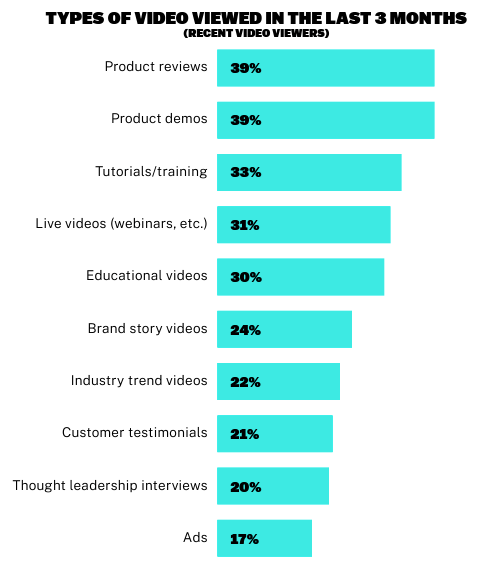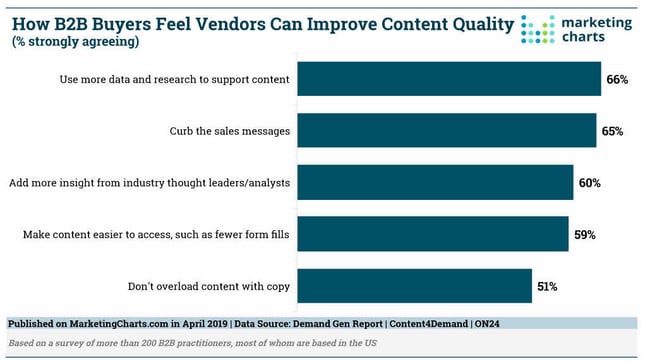If we needed to identify a single pain point that every B2B marketing team can relate to, it would be the challenge of reaching decision-makers. And this challenge is pretty universal across industries and marketing channels. However, this group holds the purse strings, so you must find a way to bring your brand, product, or service to their attention.
Direct sales are often a turn-off for this group, as most prefer to do the research themselves and decide when and how to connect with a business. The good news is that they engage with content, with 61% of B2B buyers saying they will review between three to seven content pieces before contacting a company.
To make an impact, you need to craft content that appeals to decision-makers and stands out from the competition, leading the powers that be to take the next step with your company. Here are nine insider secrets to making sure your team has the edge.
1. Know Who You’re Talking To
When you create your content strategy for content geared toward the C-suite, you’ll need to drill down on the traits that set this crowd apart from other audience segments. If you operate within multiple industries, identify what decision-makers have in common across all of them. Create a buyer persona for this group.
We recommend that you subdivide this group for more specialized content for decision makers with varying roles in a business or industry. Creating more specific buyer personas will help you identify more topics to cover and channels on which to publish your content.
2. Understand Their Pain Points
If you want to create content that captures decision-makers’ attention, dig deep to discover their pain points. Understanding the unique challenges that they face is crucial.
They want content that will help them understand how your products or services will help them solve real business problems, improve their decision-making processes, and fill their knowledge gaps. If you can create compelling content that addresses their pain points, they are more likely to pay attention. When your brand offers the solution they need, they are more likely to move at least one step closer to that RFP.
3. Identify Their Preferences
It’s crucial to craft content that this crowd wants to engage with. Video is where it’s at:
- 95% of surveyed B2B buyers indicated video content was an important factor in their decision-making process.
- 70% say videos increase awareness about the challenges businesses face.
- 58% use video content to learn about a product or service.
- 93% identify videos as important trust-building features.
Creating videos takes significant time and planning, but if you don’t include it in your content menu, you’re missing out on a great tool. Of course, you will still craft other types of content, such as blog posts, infographics, and white papers, as each has appeal and benefits.
Image Source: Brightcove
4. Go Where They Go
Take time to learn where relevant decision-makers go to grab the needed content. While it’s always a good idea to optimize your content for search engines, you should also post to the platforms they use.
While you want to ensure you post on the right channels, sometimes you need to take it a step further. Find out where on these channels they hang out. Do they follow specific types of content on LinkedIn? Are they hanging out in certain Facebook groups? The more information you can gather about where they go for content, the tighter you can make your strategy.
5. Keep It Concise
The C-suite doesn’t have much extra time on its hands. They want to consume concise, straightforward content. They also want it to be data driven, with insights they can use.
In general, we recommend keeping videos to two minutes or less and blogs at 500-1,500 words. That said, there is a place for long-form content, but use this format sparingly, and only when it serves a real purpose. White papers and e-books can be helpful to your audience, but they won’t necessarily dive into that format every day.
Image Source: MarketingCharts.com
6. Personalize Your Content
Consider this: 73% of customers in the B2B sphere say they want a personalized buyer experience on their journey, yet only 22% say they are getting it. In other words, decision-makers want the same kind of experience they have come to expect in their B2C buying journeys.
If you really want to craft content for decision-makers, create personalized content at every touch point. Make it easy for them to find the answers they seek and obtain the solutions to their problems.
7. Make It Fresh
Stay on top of trends within the industries you serve to ensure you produce and deliver fresh, relevant content. After all, topics of broader interest in the industry can also be relevant to decision-makers. You just need to make sure you tailor your content to their needs.
Though this target audience can be challenging to reach, make sure you keep the content coming and that it adds real value. As with content for any audience, don’t be afraid to freshen up an old asset to make it relevant to current needs.
8. Keep It Real
At the end of the day, decision-makers are people. If you want to write effective content for the C-suite, think of them as people first. Tell great business stories that they can see themselves in.
Remember their humanity and engage with their emotions, desires, and concerns. Your content shouldn’t sound like a sales pitch. Just as you want to speak to your audience like they are real people, you also want your content to sound authentic. Crafting engaging content is also about conveying your brand’s personality, revealing what traits make you unique and instantly recognizable through your content.
9. Maintain Organization
Staying organized is a must if you want to produce content that hits home with decision-makers and drives conversions. It’s a team effort, and you need your team to be on the same page.
When you make Divvy your team’s home field, you have an advantage over companies still using multiple platforms and communications methods.
Your team can collaborate, plan, schedule, create, communicate, and analyze from one platform with a user-friendly dashboard and more than 1,000 integrations. Are you ready to end the chaos and focus your efforts on producing content that captures the C-suite’s attention? Request a demo to see how you can make Divvy part of a winning team.


